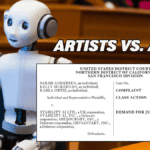Is the creation of an interpolated demo recording fair use or garden-variety infringement?
That’s one of the questions the court will need to tackle in connection with Tracy Chapman’s ongoing copyright infringement lawsuit against Nicki Minaj.
Chapman alleges that Minaj infringed her 1988 hit “Baby Can I Hold You” by incorporating the song’s lyrics and melody into a new hip hop version called “I’m Sorry.” Had this derivative work been a true “cover” version of Chapman’s composition, Minaj would have qualified for a compulsory license. This is presumably what allowed artists as diverse as Neil Diamond, Boyzone and even Billy Bob Thornton to previously cover the song. But because Minaj “interpolated” the Chapman song by intertwining new lyrics and melodies with the original, she needed to get Chapman’s permission.
Minaj repeatedly tried to obtain a license to release “I’m Sorry” on her then-forthcoming album “Queen.” But Chapman, well known in the music industry for denying requests to sample her songs, turned Minaj down several times.
Both sides seem to agree on these basic facts, but they part ways on what happened next. Chapman alleges that Minaj, unhappy with Chapman’s decision to deny her a license, leaked the song to New York DJ Funkmaster Flex, who played it on his radio show.
Minaj claims that while she had originally planned to send a copy to Funkmaster Flex, she had a “change of heart” at the last minute. While it’s clear that someone leaked the unreleased demo, Minaj swears it wasn’t her.
As Eriq Gardner discussed this week in a piece for The Hollywood Reporter, Chapman filed a motion for summary judgment in the case, asking the court to rule that Minaj is liable for copyright infringement. If granted, this would leave damages as the only thing left for a jury to determine. Minaj says that a jury needs to decide the issue of liability too—particularly whether or not she was actually the source of the leaked demo.
Meanwhile, Minaj has filed a summary judgment motion of her own. Setting aside the dispute over the song’s unpermitted distribution, Minaj asks to court to rule that her initial copying of “Baby Can I Hold You” to create the demo qualifies as a “fair use” of Chapman’s song. If this were not the case, Minaj argues, artists would be forced to seek and pay for a license before they could even begin experimenting in the studio, a process that fosters the sort of creativity the Copyright Act is designed to promote.
Chapman isn’t buying it. In an opposition filed earlier this week, her lawyers say there’s no authority for the proposition that the creation of a “demo version” of a work—even if it were made solely for the purpose of seeking permission—is fair use. Chapman notes that the Copyright Act gives copyright owners the exclusive right to prepare derivative works—and to prevent others from doing so. She wants the court to hold that Minaj’s preparation of the demo recording did not constitute a fair use as a matter of law.
So who’s right? Was the preparation of the “Sorry” demo recording fair use? While not discussed by either of the parties in their briefs, prior cases involving so called “intermediate copying” can help give us a framework for thinking about this issue.
Intermediate copying is the process of reproducing a copyrighted work as a interim step in the creation of a new copyrighted work. For example, imagine that an advertising agency wants to use the Beatles’ “I Feel Fine” in a commercial for headache medicine but knows it’s never going to be able to get permission. So, the agency copies the song as temporary background music and tells a commercial production company to create a new song that has the same vibe as the original but doesn’t infringe. Assuming that the version with the temp track isn’t mistakenly released (which I’ve seen happen by the way) and isn’t substantially similar to the original, is the original internal copy nevertheless an infringement?
Copyright law is pretty clear that, subject to the right of fair use, infringement occurs whenever unauthorized reproductions are made. In other words, public or private, commercial or noncommercial, a copy’s a copy. While it’s unlikely you’ll be sued for making a copy that never sees the light of day, I’ve seen stranger things.
The court in Walt Disney v. Filmation Associates dealt with this issue years ago. Disney claimed that the defendant had copied materials from “Pinocchio” in the process of creating “The New Adventures of Pinocchio,” a film that at the time of the lawsuit had not been distributed (or even completed). The court rejected Filmation’s argument that it couldn’t be liable for infringement in the absence of a completed film, holding that the Copyright Act prohibits unauthorized reproduction “even if the creator considers those copies mere interim steps toward some final goal.”
But even though interim copies are not exempt from copyright infringement claims, are they nevertheless considered fair use?
Most of the law in this area deals with cases involving computer programs. Video game and software companies may “reverse engineer” the code from copyrighted programs en route to creating a final work that is itself not infringing. For example, in Sega Enterprises v. Accolade, the defendant copied Sega’s video games in order to access the functional code necessary to create its own games that would be compatible with Sega’s console. The Ninth Circuit held that while the Copyright Act “unambiguously” encompasses intermediate copying, Accolade’s conduct was permissible under the fair use doctrine. Accolade’s interim copying was a fair use because it was a necessary step in acquiring the compatibility code (which was not protected by copyright) and because it increased the public’s access to independently designed video games.
The concept of intermediate copying doesn’t come up too much outside of the software context. One of the reasons is because these sorts of copies are usually inconsequential. If the intermediate copying was used to create a final work which is itself infringing, a plaintiff will typically only assert a claim against that final, published work.
But what if the final work is not infringing, either because of fair use or because it’s not substantially similar to the original? Take the example of parody songs or movies. When someone produces one of these works, it’s reasonable to assume that they reproduced a copy of the original somewhere along the way. If the final parody version is a fair use, it stands to reason that the intermediate copying would be fair as well. If this weren’t the case, parties would be discouraged from creating works that build on prior art, thereby depriving the public of works that are themselves fair.
There have been cases in which a defendant never released a “final work,” but the plaintiff asserted a copyright claim based solely on the defendant’s intermediate copying. One example that bears some similarity to the Chapman/Minaj dispute is Sundeman v. Seajay Society.
The case involved an unpublished novel written by Pulitzer Prize-winning author Marjorie Kinnan Rawlings called “Blood of My Blood.” The manuscript was part of a collection of Rawlings’ private papers and correspondence that belonged to her estate. Years later, representatives of one of the defendants obtained access to the documents and copied “Blood of My Blood.” They made the copy both so that the fragile original wouldn’t be damaged in the course of preparing a literary analysis, but also so that they could send it to a book publisher to see if it was worthy of publication. The defendants recognized that they couldn’t actually publish the book without the estate’s permission, and in fact they didn’t publish it. Nevertheless, Rawlings’ estate filed a copyright infringement lawsuit, contending that defendants were liable for their interim copying.
The Fourth Circuit held that the defendants’ copying was a fair use of Rawlings’ novel. The copy was made for a purpose that served the public interest and the development of the arts, not to supplant the original. The court also found no market harm. If anything, the defendants’ actions may have actually increased the demand for Rawlings’ novel—which was ultimately published years later.
Unlike the other cases I’ve talked about, Chapman’s lawsuit is somewhat unique because she not only asserts a claim based on Nicki Minaj’s distribution of the “Sorry” demo, but also a claim based on the demo’s creation in the first place. Minaj’s motion attempts to sever these two claims, arguing that even if the distribution were infringing, the initial reproduction was a fair use.
What we see from the cases is that while courts may analyze an intermediate copy separate from the ultimate published work (as in Sega), usually the ultimate purpose to which a copy is put will be relevant in determining whether an interim copy is a fair use. In other words, the status of the final product will guide the court’s analysis of the initial reproduction.
For example, let’s assume that Nicki Minaj had actually created her work, not with the intent to seek Tracy Chapman’s permission to release it, but rather for the express purpose of leaking the song to a radio station. In this case, it’s hard to ignore the act of distribution in determining whether the act of reproduction was fair. To the extent disputed questions remain about how “Sorry” ended up in the hands of a New York DJ, the court may be inclined to reserve judgment on whether the song’s initial creation was fair as well.
What do you think? Fair or no fair? Let me know in the comments or on the Copyright Lately socials.
UPDATE—Earlier this week, lawyers for Nicki Minaj filed their reply brief in support of her fair use motion. Minaj had been called out in Tracy Chapman’s opposition for failing to cite “a single case” supporting her argument. In reply, Minaj countered with the Sundeman “Blood of My Blood” opinion we discussed here first on Copyright Lately. Maybe the judge will read us too!
UPDATe TO THE UPDATE—On September 16, the Court granted Minaj’s motion of partial summary judgment finding that Minaj’s “intermediate copying” in creating “Sorry” was a “fair use” of Chapman’s “Baby Can I Hold You.” Read all about the decision and my take here.







9 comments
After listening to both Nicki Minaj’s song (https://www.youtube.com/watch?v=xlFZbWACUSI) and Tracy Chapman’s, I don’t think it’s fair use notwithstanding the new song’s status as an unofficial, demo recording. As for “good faith” and “intent,” I don’t think Minaj’s intent matters at all, and I recall from Campbell that “being denied permission to use a work does not weigh against a finding of fair use.” The fact is that the work was distributed by a leak. If it’s infringing, it’s infringing. If there’s no real harm because it was never officially distributed/sold, that can be argued to the jury in finding damages — but I think there should be liability here. Minaj’s song also sounds a lot like a cover, so thanks for your explanation of “interpolation” as opposed to what would be subject to a compulsory license.
Section 115 says that “[a] compulsory license includes the privilege of making a musical arrangement of the work to the extent necessary to conform it to the style or manner of interpretation of the performance involved, but the arrangement shall not change the basic melody or fundamental character of the work.” That’s why interpolations don’t count. It’s also why someone like Weird Al can’t rely on this provision to do parody songs.
Is there a distinction to be made between the (presumptively) private sharing to an otherwise outside party (Flex) of a finished work as opposed to the sharing made of an unfinished work during the creative process? Or is that the same as Rawlings?
The Copyright Act doesn’t really care about “finished” vs. “unfinished” works. And the recording allegedly sent to Flex was an unmastered demo in any event. But your point about “sharing” raises a couple of interesting issues.
First, Chapman’s lawyers are arguing that Minaj violated Chapman’s section 106(3) distribution right by sending the recording to Flex. If she only sent it to him, then arguably it’s not a “public” distribution as opposed to a “private” distribution that isn’t covered by section 106(3). Of course, if Minaj *did* send the recording to Flex (which she denies), it was for the purpose of Flex broadcasting it on his radio show. However, the act of transmitting a sound recording over radio airwaves, while “public,” doesn’t constitute a “distribution” under the Act. If you really want to get technical, some people would argue that sending the audio file via text message, whether public or not, may not implicate the distribution right either. That’s because section 106(3) talks about the distribution of “copies,” which are defined elsewhere in the statute as “material objects.” But we’re talking here about digital files, which are arguably not material objects. This is seen as a pretty extreme position though, and the Copyright Office has criticized it.
Finally, it’s unclear to me why Chapman’s lawyers didn’t assert that the transmission to Flex was a violation of the reproduction right under section 106(1). When someone texts a digital file, the sender still has her copy, and the recipient now has one as well.
As you can see, these issues are probably deserving of a separate post at some point. Thanks for reading!
You really make it seem so easy with your presentation but I find this topic to be really something which I think I would never understand. It seems too complex and extremely broad for me. I’m looking forward for your next post, I’ll try to get the hang of it!|
Hi there – it’s definitely not easy, so don’t be hard on yourself. My advice is to start with the basics and work your way up. I’m planning to publish some “Copyright 101” posts soon, but in the meantime if you let me know what level you’re at and what you’re interested in learning, I can point to some resources.
Thanks for reading!
Aaron
The DJ the song was leaked to is Funkmaster Flex not Flexmaster Flex.
Fixed – Thanks!
An insightful read that sheds light on Tracy Chapman, Nicki Minaj, and the importance of respecting artists’ rights.